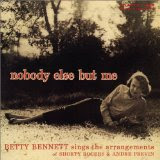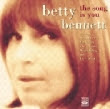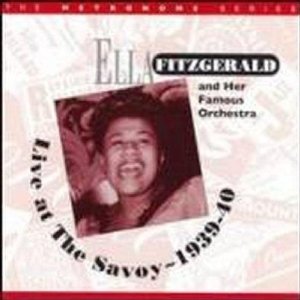During the past few months, both Betty Bennett and Mundell Lowe swung past their 90th birthdays. Although Betty has not sung publicly recently, Mundy continues to play guitar and his performances demonstrate that there is no failing in either his dexterity or his invention. This can be seen and heard in these videos taken during his birthday bash at John Pisano’s Guitar Night at Lucy’s 51 in Los Angeles in early March 2012.
For the benefit of anyone who has not encountered Betty and Mundy, a little background might be useful. Betty Bennett was born 23 October 1921 in Lincoln, Nebraska. As a child, she hoped to become an opera singer and studied voice and piano. A stop was put to that, probably inadvertently, when, by way of records, her mother introduced her to the music of Duke Ellington and Count Basie. Loving what she heard, Betty changed direction and quickly became proficient in jazz singing, displaying a natural talent for the form. While still very young, she joined Georgie Auld’s band and then in quick succession spent time in the big bands led by Claude Thornhill, Alvino Rey and Charlie Ventura and she was also briefly with Stan Kenton and Woody Herman. The Ventura band bore the promo tag ‘Bop for the People’ and Betty’s contemporary styling was a perfect fit. Apart from airshots, Betty’s recording career got underway with the Ventura band’s sessions in 1949 and continued into 1951. These included performances of Yankee Clipper, Too Marvelous For Words and I Can’t Get You Out Of My Mind. Betty’s experiences in these years are entertainingly recounted in her autobiography, The Ladies Who Sing With The Band, which was published in 2000.
In 1953, Betty recorded her first own-name album. This was for Trend and included songs such as Nobody’s Heart, Time After Time and You’re Nearer. Two years later, she recorded Nobody Else But Me for Atlantic Records accompanied by a band led by André Previn, whom she had married in 1952. Among leading jazzmen of the day in this band were Shorty Rogers, who with Previn also wrote the charts, Frank Rosolino, Bob Cooper, Jimmy Giuffre, Barney Kessell and Shelly Manne. Similarly star-studded were the trio and quartet Previn fronted for a 1959 United Artists date: Conte Candoli, trumpet, Red Mitchell, bass, Irv Cottler, drums. The resulting album was aptly titled I Love To Sing.
In addition to club dates, Betty had also begun appearing on the festival circuit and in 1975 she celebrated a new personal relationship when she and Mundell Lowe were married at a ceremony held at the Monterey Jazz Festival.
Mundell Lowe’s career had begun way back in 1935. He was born 21 April 1922, in Laurel, Mississippi and began playing guitar at the age of six. At age thirteen he left home and set out for New Orleans. There, he haunted the city’s clubs before his Baptist minister father found him and hauled him back home. He showed his determination to have a career in music when just a few years later he headed for Nashville where he played in the Pee Wee King band. Then came a short stint with Jan Savitt’s band but military service now intervened. Fortuitously, he was posted to a camp near New Orleans where at an adjacent camp he encountered John Hammond Jnr. After the war, Mundy and Hammond met up again and the entrepreneur introduced him to Ray McKinley, now leader of the Glenn Miller band. The second half of the 1940s and on through the 1950s saw Mundy playing guitar in clubs and on record dates with an astonishing array of late swing era notables and many rising stars of early bop. These musicians include Benny Goodman, Wardell Gray, Fats Navarro, Red Norvo, Lester Young, Buck Clayton, Charlie Parker, Billie Holiday, Miles Davis and Sarah Vaughan.
During the 1950s, Mundy played regularly in the NBC television studio orchestra and he was also musical director on the Today show. Aside from music, he also acted on and off Broadway. That aside, music remained the main thrust of his life and he played and often recorded with musicians such as Georgie Auld, Ruby Braff, Mel Powell, Tony Scott, Ben Webster, the Sauter-Finegan Orchestra and Joe Venuti. Mundy also backed many singers on record dates, among whom are Sammy Davis Jnr., Tony Bennett, Chris Connor, Ruth Brown, LaVern Baker, Connee Boswell, Helen Merrill, Lee Wiley and Carmen McRae. Mundy continued to work in television and radio after his 1965 move to Los Angeles. It was here that he began to be recognized as a writer of scores for films and television and also as an exponent of 12-tone music.
A regular at the Monterey Jazz Festival, among many engagements was a 1983 performance by his small band, Transit West, in which he was teamed with Sam Most, Monty Budwig and Nick Ceroli.
The marriage of Betty Bennett and Mundell Lowe at Monterey in 1975 was also a joining of musical minds, a quality that has continued as is apparent from the 1990 recording session that resulted in The Song Is You. Here, accompanied by Bob Cooper, George Cables, Monty Budwig and Roy McCurdy, the couple perform fine interpretations of songs such as You Must Believe In Spring, No More Blues, I Thought About You and The Eagle And Me.
Separately and together, over the years Betty Bennett and Mundell Lowe have made significant contributions to jazz that are always lithely swinging. Betty’s singing, lyrically profound and musically adventurous, and Mundy’s elegant and deceptively sparse exploration of the often overlooked subtleties of many compositions have allowed them to create memorable interpretations of the standards from the jazz and popular song repertoires.
Betty’s extensive collection of photographs and other memorabilia is now with the Rutgers University's Institute of Jazz Studies although some photos can be seen on the JazzWax website.
Mundy’s own website is where you can find details of this indefatigable musician’s forthcoming gigs.
Remember that Jazz Journal’s website is where you can subscribe to this fine magazine, now in its 65th year.



























